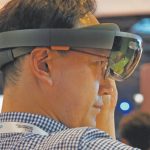Microsoft’s new virtual reality technology
Microsoft’s Hololens headset, led by Alex Kipman, has been a large part of the technological media scene for the past two years. Kipman, who led the software design team, is one of the core creators of the device.
The Hololens is a simple and lightweight machine built for entertainment and productivity. It features Windows 10 and functions like a computer. The Hololens goes over the eyes like a headband and aids in daily activities by incorporating apps and widgets to place around a home and workplace. There is no outside wiring to the machine, and it develops holographic images to whoever is wearing the headband. Microsoft describes the Hololens as a “more natural way to interact” with the environment. The purpose was to blend reality with virtual reality and incorporate graphics into the real world.
“People, not devices, are mobile. We are ready for technology to move beyond devices, beyond screens and pixels, and beyond today’s digital borders,” said Kipman.
The initial announcement for the first Hololens was in January of 2015, and over the past two years, Microsoft has been working to introduce the device out into the public. Within the first quarter of 2016, a prototype developer’s version was aired.
In May 2016, Kipman released a blog post expressing some highlights and updates on the Hololens. For one, the device now allows the user to run multiple applications at the same time. There are also added inputs to the device — such a being able to connect a mouse for smoother usage. Voice commands were also added that allow the user to speak commands to the headband. Photo capabilities are the last of the major updates, and provide users the freedom to post pictures on any wall from the application.
The developer’s editions are still being used — and Microsoft will soon allow any user to purchase a Hololens. While Microsoft has yet to provide a release date, they hope to grant all consumers access to their device in 2017.






